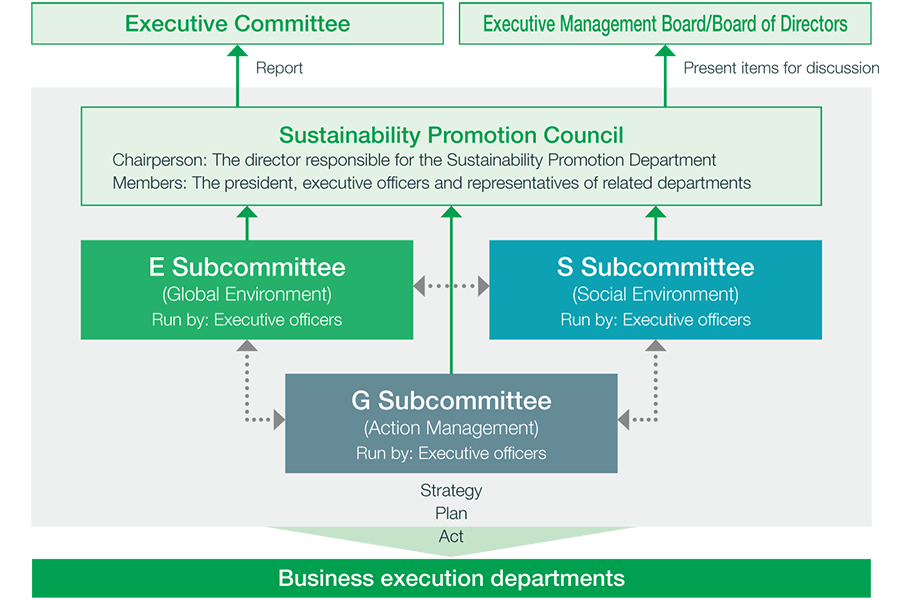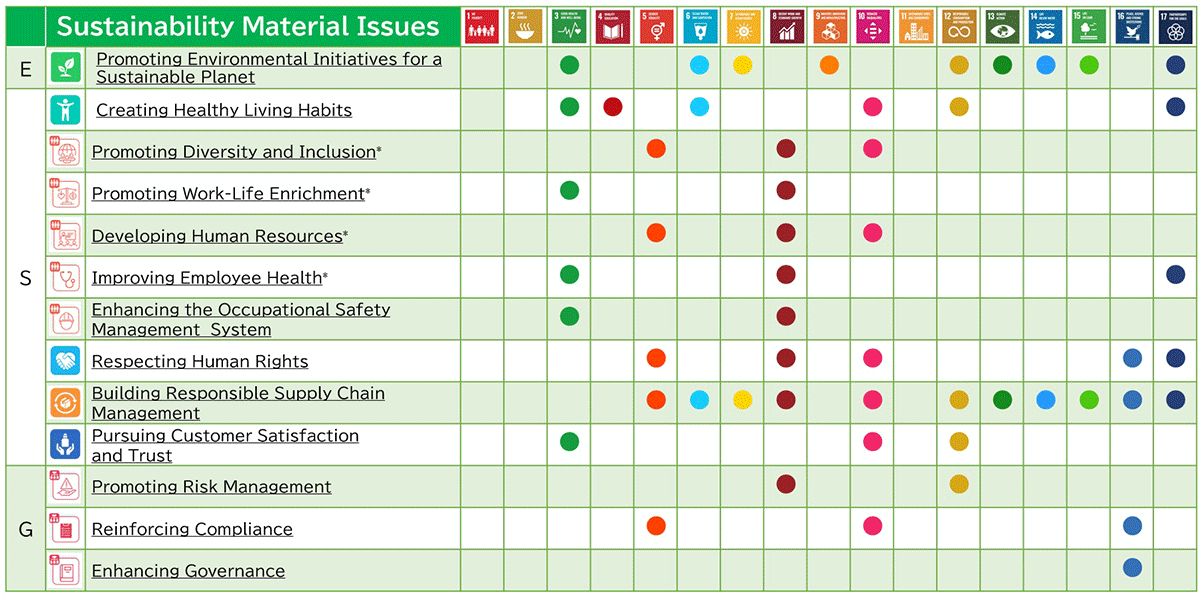Upholding its founding spirit of “benefiting society through its business activities,” Lion, in addition to pursuing economic development, has long considered its impact on the environment and society and worked to address related issues through its business activities.
At present, we are tackling key management issues to reduce risks and achieve our management vision for 2030 of “Becoming an advanced daily healthcare company.” At the same time, we are practicing management driven by our purpose, “Make a difference in everyday lives by redesigning habits: ReDesign.”
In order to promote sustainable management, until 2020 we held the Sustainability Promotion Meeting, comprising all executive directors, including the president, and related departments. In 2021, we revised the Sustainability Promotion Council, convening twice a year.
We have established the E, S and G subcommittees under the council, each headed by an executive officer, to promote and monitor initiatives for the Sustainability Material Issues. Decisions made by the council are shared with the Executive Committee and, as necessary, presented to and discussed by the Executive Management Board and the Board of Directors, before being reflected in the business activities of the business execution departments.

With an eye to achieving its management vision of “Becoming an advanced daily healthcare company” by 2030 and contributing to the Sustainable Development Goals (SDGs), a set of shared global goals for 2030, the Lion Group has established the Lion Group Sustainability Material Issues and objectives for 2030.
The Lion Group believes that it is crucial to take a longer-term perspective in order to ensure that it can continue to meet the needs of society and customers and grow its businesses. In 2021, in light of the COVID-19 pandemic and changes in the social environment, we revised our objectives and indicators. Aiming for a higher level of achievement, the 2030 objectives include quantitative indicators for evaluating our progress.
Taking an integrated approach that incorporates sustainability into management strategy, the Lion Group aims to contribute to the realization of a sustainable society and achieve further business growth.
| Material Issues | Objectives(2030) | Progress (2024 Results) |
|---|---|---|
| E(Environment) Top-Priority Material Issues ① 
|
Reduce CO2 emissions throughout business activities. |
|
| Reduce CO2 emissions throughout product lifecycles. |
|
|
| Achieve a CO2 emissions reduction effect in excess of Lion’s own emissions to help society become carbon negative. |
|
|
| Actively promote the 3Rs (reduce, reuse, recycle) and renewable resource activities. |
|
|
| Reduce water usage throughout product lifecycles. |
|
|
| S(Social) Top-Priority Material Issues ② 
|
Provide opportunities for everyone to practice oral healthcare whenever necessary and foster oral health care habits to promote health for all. |
Oral health care habits: 400 million people* Spreading Awareness of Preventive Dentistry Habits (Japan)
(Overseas)
Putting Preventive Dentistry Habits into Practice (Japan)
*Source: Lion survey |
| Promote the establishment of cleanliness and hygiene habits that prevent bacteria and viruses from entering the body across all aspects of daily living, so that everyone can stay healthy. |
Cleanliness and hygiene habits: 310 million people* Promoting and Establishing Cleanliness and Hygiene Habits through Educational Institutions (Lion Group)
Expanding Activities in the Domain of Establishing Cleanliness and Hygiene Habits (Japan)
(Overseas)
*Based on 2024 performance, a new calculation method was adopted, expanding the scope of activities to include personal and food safety, in light of business conditions in Asia |
|
| S(Social) ③ 
|
Enable human resources with diverse values and ideas to fully express their individuality and abilities and succeed professionally. |
|
| S(Social) ④ 
|
Create an environment that helps employees fulfill their ambitions through synergy between work and private life. |
|
| S(Social) ⑤ 
|
Foster human resources who generate dynamism to realize innovative change by creating environments that enable all employees to exercise their diverse abilities to the fullest and embrace challenges. |
|
| S(Social) ⑥ 
|
Support mental and physical healthcare for employees to reinforce Group human resources and achieve sustainable corporate growth. |
|
| S(Social) ⑦ 
|
Enhance systems to ensure compliance with occupational safety and health laws and regulations and to enforce safety awareness thoroughly for the safety and peace of mind of employees and outside partners working on site. |
|
| S(Social) ⑧ 
|
Ensure respect for the human rights of all stakeholders affected by Group business activities, in line with the LION Human Rights Policy. |
|
| S(Social) ⑨ 
|
Implement sustainable procurement with zero tolerance for human rights and labor problems (including child labor and forced labor) or environmental destruction in line with the Sustainable Material Procurement Policy and Lion Group Supplier CSR Guidelines. |
|
| S(Social) ⑩ 
|
Promote and reinforce customer-oriented business activities by improving customer support quality and the value of products and services. |
|
| G(Governance) ⑪ 
|
Build a comprehensive and exhaustive risk management system for identifying and quickly and appropriately dealing with risks to achieve sustainable corporate growth. |
|
| G(Governance) ⑫ 
|
Reinforce effective initiatives to instill compliance awareness and thus earn and maintain the trust of society. |
|
| G(Governance) ⑬ 
|
Build a sound, fair, transparent and highly effective governance system to enable sustainable corporate value enhancement. |
|
*The four items related to human capital will be revised and updated targets and indicators will be promoted starting from the 2025 results.
*The historical data contained an error, which has been corrected in the figures.


*The four items related to human capital will be revised and updated targets and indicators will be promoted starting from the 2025 results.

Identifying Material Issues

Lion’s History (Sustainability)

Initiatives and External Evaluations

ESG Data and Third-Party Verification

Stakeholder Engagement

Social Contribution Activities
Lion focuses on sustainability for itself and for the world in terms of environmental, social, and economic factors. A sustainable company is one that considers not only economic development, but also social and environmental impacts as it implements ongoing business activities based on long-term strategy.
The Sustainable Development Goals (SDGs) are a set of common goals for 2030 established by the United Nations (UN) aimed at the realization of a sustainable world.
The Lion Group’s contribution will mainly be to the realization of SDG 3, “Ensure healthy lives and promote well-being for all at all ages,” through its products and services. At the same time, by pursuing initiatives aimed at realizing the Vision 2030 long-term strategic framework, we will contribute to the creation of a sustainable world, the ultimate goal of the SDGs.